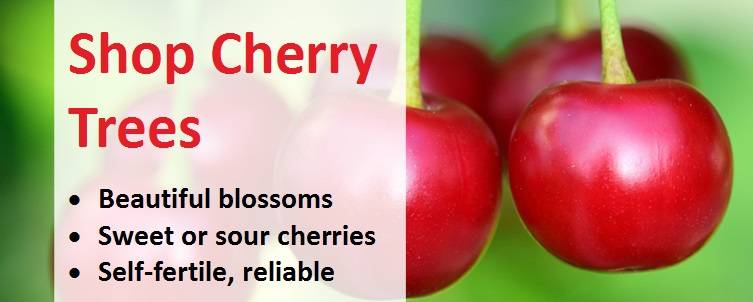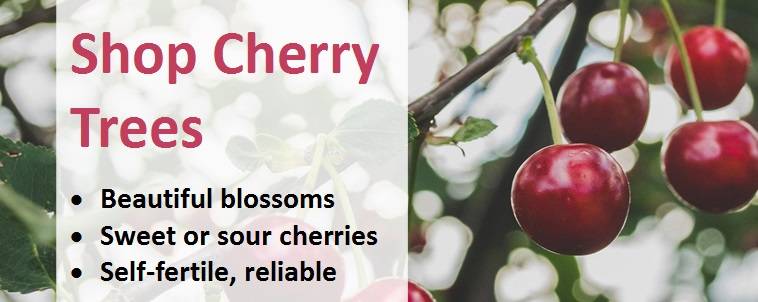How to Grow Your Own Cherry Tree
Cherry trees are attractive and versatile, providing delightful spring colour when they are in full blossom and, in many cases, outstanding autumn colour as well. Native to most of Europe, western Asia and parts of northern Africa, they can be positioned in a spacious part of the border, used as a centre-piece, feature tree or even container grown. For many, cherry blossoms are characteristic of the change in season from winter to spring due to their beautiful density and lovely hue. Distinctive pink or white flowers are borne in bunches or racemes in April, adding a fabulous flush of colour to your garden and making it the envy of your neighbours.
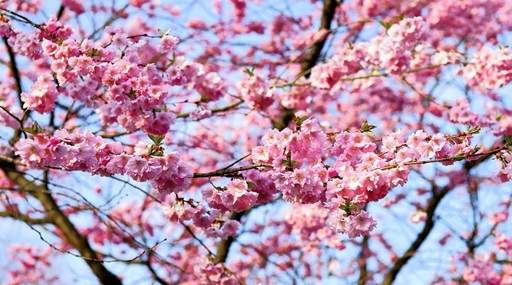
Cherry trees have beautiful, distinctive pink or white blossoms
There are 2 main types of cherry tree - sour cherries (Prunus cerasus) and sweet cherries (Prunus avium), the latter also known as the sweet cherry tree. Sweet cherries are those sold fresh in most markets; they bloom slightly earlier than sour cherries and can be eaten fresh from the tree. Sour cherries (also referred to as tart cherries) are tangy, juicier and slightly sour, making them best suited to cooking and baking, although they can still be eaten fresh if allowed to over-ripen on the tree. Tart cherries are the type used to make delicious pies and jams. Sweet cherries require full sun to produce good crops, whereas sour cherries can also be grown in shady positions. Self-fertile varieties of both types are available, so there is a type of cherry to suit every garden and personal taste.
Recommended Cherry Varieties
The best cherry varieties are:
Cherry avium Stella- sweet cherry reliably produces an abundance of dark red fruits with a delicious, juicy taste ready for harvesting in late July. Self-fertile and easy-to-grow, it also produces an attractive display of white flowers in mid-spring and is the perfect choice for those new to growing fruit trees. Stella will pollinate other cherry trees that are not self-fertile.
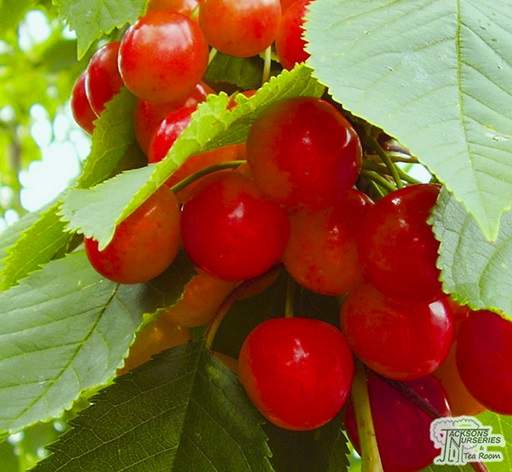
Cherry cerasus Morello - prolific tart cherry with sizeable, dark red fruits with a sour, acidic taste. Ready for harvesting in August, they are perfect for incorporating into a wide range of culinary recipes, including pies, crumbles and jams. Self-fertile and a reliable cropper, with a compact, spreading growth habit which is very attractive when in blossom.
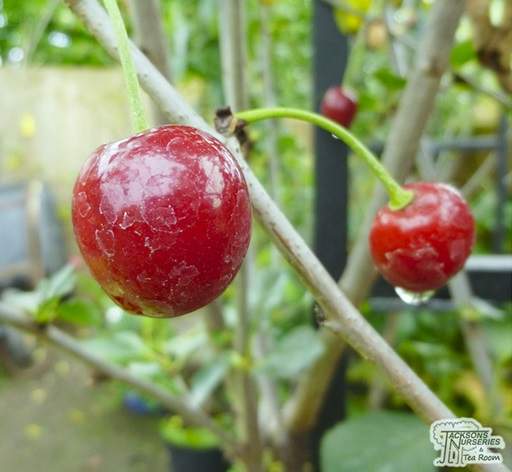
Fruit
Acid cherries are all self-fertile, whilst some sweet cherries require a pollination partner (although our recommended sweet cherry, Cherry avium Stella, is also self-fertile). Sweet cherries fruit at the base of one-year old wood and on older wood, whilst sour cherries fruit along the length of one-year old wood. Fruiting is prolific - especially in established trees - with cherries maturing early and fast. After your cherries have swollen and started to change colour, their skin stops growing, so any excessive moisture absorbed through the skin can cause the fruits to burst. To prevent this from happening, protect your fruits from rainfall when they start to develop using a length of clear plastic over the top of the tree, making sure air circulation around the trunk and lower branches is not impaired.
A good blossom depends on the conditions experienced the previous year, and good blossoms in turn result in an strong crop of fruit. When fruits develop, protect them from preying birds using netting or fleece. The sugar content of cherries rises dramatically in the last few days of ripening, so wait until they turn fully red before harvesting. When the fruits begin to drop, they are ready to pick. The fruits of Stella cherry trees should be deep red before picking. Before you pick a large number of your sweet cherries, have a taster to check they're full of flavour and sweetness. Harvest cherries in dry weather as they ripen over the course of about a week. Cut the stalks with scissors and lay them down gently into a bowl or basket to avoid bruising the fruit; pulling fruits off with your hands is more likely to cause injury to the fruits or tree, resulting in infection of your tree or a lower quality crop. Leave the stalks on the cherries but be careful not to tear the fruit spur from your tree as this is what will product fruit year after year.

Cherries are normally ready to harvest between June and August
Cherries are an excellent fruit to grow because they are expensive to buy and often bruised or damaged in transit on the way to or in the supermarket. Sweet cherries are best eaten as they are (or with a sprinkle or sugar if you have a sweet tooth!) as soon as possible after being picked. They make a great addition to al fresco dining if the weather permits. Tart cherries, on the other hand, are too acidic for most peoples' tastes when eaten fresh (unless left on the tree to sweeten for an extra day or two) but make excellent pies, puddings, cakes and preserves. Both types are high in fibre and vitamin C, so they not only taste delicious but are also good for you too! If the short harvesting season means you have too much fruit, cherries can be frozen providing their pips are removed first. We recommend freezing on a tray before putting in plastic bags to avoid ending up with one mass of cherries stuck together that must all be eaten in one go.
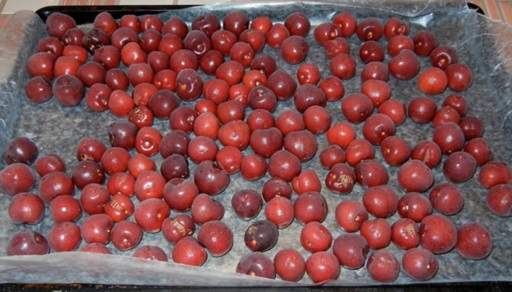
Freeze cherries on a tray before putting them into plastic bags to prevent them from sticking together
Cherry Tree Planting Advice
Containerised cherry trees can be planted at any time of year when the ground is not frozen, lying wet or very dry after a prolonged spell of dry weather, but planting in late winter to spring is always the best option. Bare root fruit trees should ideally be planted as soon as possible after receiving them; if this is not possible, store your tree in a cool, frost-free shed or outbuilding and place the roots in a bucket of water until you're able to plant. Sweet cherries require full sun to produce good crops, whereas acid cherries can also be grown in semi-shady positions. All types of cherry trees have very shallow roots, so require a well drained soil to avoid water logging; they dislike shallow, sandy or badly drained soils. Good air circulation through the branches is also vital, so ensure your chosen site provides the cherry tree with sufficient room to grow in future years.
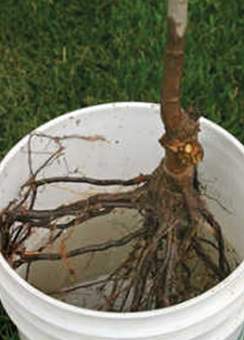
If bare root fruit trees cannot be planted straight away, keep the roots in water in a frost-free place
Start by digging over the planting site and removing all weeds. Cherry trees do not like competition from other plants, so continue to keep the area one metre around the tree from grass and weeds, especially as the plant first becomes established. Dig plenty of organic matter such as leaf mould, well-rotted garden compost or manure into the planting hole. You may also wish to sprinkle some mycorrhizal fungi at the bottom of the hole to stimulate rapid root growth. Aim to plant the tree in your garden at the same depth as it has been grown at to date (this can be easily established by looking for the colour change from dark to light as you move down the trunk towards the roots). For container-grown trees, remove the plant from its pot and eliminate circling roots by laying the root ball on its side and cutting through the roots with shears. If the tree is grafted, position the inside of the curve of the graft union away from the afternoon sun. Provide support to the tree with a stake and tree tie. If you decide to grow your cherry tree in a container (often preferred in smaller gardens), use a soil-based potting compost such as John Innes No. 3.
Garden Care
The same cherry tree garden care guidance applies whether you choose a sweet or tart variety. Apply an organic mulch each spring to help keep soil moisture at a constant level, suppress weeds, keep roots cool and prevent damage from lawn mowers or string trimmers. Pruning and fertilisation is not recommended during the first year after planting as young trees naturally grow quickly and growth that is too rapid is associated with bacterial canker disease. Instead, spread the branches when young to help control height and encourage earlier bearing.
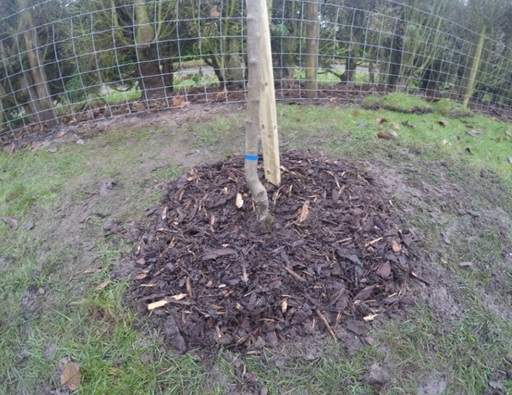
Mulch your cherry tree each spring to promote moisture retention and suppress weeds
Be sure to water regularly during periods of prolonged dry weather. If a disease does develop on your plant, be scrupulous about cleaning up blossoms, fruit and leaves that might be affected. Blossoms should be protected from any late frosts and, when the cherries start to develop, we recommend draping netting over your tree to prevent birds from stealing your valuable crop. Cherries are particularly sensitive to moisture availability in the last 2 weeks of ripening. If the soil is too dry, the swelling cherries will shrivel; if it is too wet, they will crack and split.
Pruning
Prune in summer (never in the dormant season) when the tree is in leaf and after the flowering season to reduce the risk of silver leaf disease and encourage new fruiting wood, painting large cuts with wound paint. The aim of pruning is to create an open, well-shaped, goblet-formed tree with well-spaced branches which are not overcrowded. In particular, any branches larger than half the diameter of the trunk should be removed. Effective pruning will allow light to penetrate the middle of the tree and improve air circulation, stimulating new growth and reducing the risk of diseases such as brown rot. Always cut back to an outward facing bud, to encourage growth away from the centre of the tree. Additionally, remove any dead, diseased, damaged, drooping or weak branches, as well as any that cross over one another, immediately after the fruit harvest. Be wary of pruning during the dormant season as this is likely to result in infection of the tree.
Share this page:

